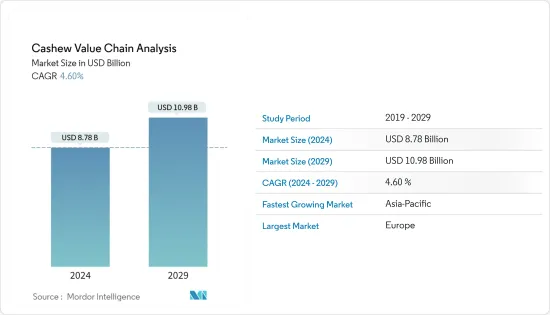
|
市場調査レポート
商品コード
1444140
カシューバリューチェーン分析:市場シェア分析、業界動向と統計、成長予測(2024~2029年)Cashew Value Chain Analysis - Market Share Analysis, Industry Trends & Statistics, Growth Forecasts (2024 - 2029) |
||||||
カスタマイズ可能
適宜更新あり
|
|||||||
| カシューバリューチェーン分析:市場シェア分析、業界動向と統計、成長予測(2024~2029年) |
|
出版日: 2024年02月15日
発行: Mordor Intelligence
ページ情報: 英文 70 Pages
納期: 2~3営業日
|
全表示
- 概要
- 目次
カシューナッツ市場規模は2024年に87億8,000万米ドルと推定され、2029年までに109億8,000万米ドルに達すると予測されており、予測期間(2024年から2029年)中に4.60%のCAGRで成長します。

主なハイライト
- カシューナッツは果物ごとにナッツが1個しかないため高価です。カシューナッツの木は栽培、収穫、偽果からの分離、ロースト、冷却、割り、皮をむき、天日干し、選別する必要があり、それから初めて生のナッツとして販売することができます。付加価値の量は、それに費やされる労働の量に比例しません。カシューバリューチェーンは、個人の栽培者と栽培協同組合、収集業者、地元の貿易業者、輸出業者で構成されます。
- 個人の生産者と生産者協同組合がカシューナッツを生産する利害関係者です。ピスツールとしても知られる地元の仲買人は、農場から生のカシューナッツを収集し、契約上のバイヤー、加工業者、貿易業者などのさまざまなバイヤーに販売する重要な仲介者です。生のカシューナッツの流通における地元の貿易業者には、個人のバイヤーと契約に基づくバイヤーが関与しており、彼らはさらに製品を国内消費および輸出のために加工ユニットおよび輸出業者に販売します。また、生または加工されたカシューナッツの輸出業者は輸出協同組合で構成されます。そして輸出会社。輸出協同組合は、輸出割当を満たすために、主に生産者協同組合から生のカシューナッツを購入しますが、場合によっては個々の生産者から生のカシューナッツを購入します。
- 最近、毎日の食事や健康的なインスタントスナックにカシューナッツを使用する傾向が高まっています。カシューナッツを注入した製品メーカーの数が増加し、米国ではカシューバターヨーグルト、インドではローストしてスパイスでコーティングしたカシューナッツなど、革新的な製品を発売し、若い消費者や高齢者の消費者を魅了しています。したがって、長期的には、先進国市場と新興市場におけるカシューナッツベースの小売メーカーの高い普及率と、アフリカでのカシューナッツの生産と加工の取り組みの成功した実施が、予測期間中にカシューナッツ市場を牽引すると予想されます。
カシューナッツ市場の動向
カシューナッツの生産促進に向けた政府の取り組みの強化
カシューナッツの栽培は、個々の生産者と生産者協同組合が主な利害関係者として、それぞれのバリューチェーンの適切に構築された段階で行われます。しかし、カシューナッツの栽培は個々の農場に非常に集中しており、規模や面積が比較的小さい協同組合の一部として運営されている生産者は少数です。
アフリカの政府は市場を改革し、制度的インフラを活性化しています。たとえば、「アフリカカシューイニシアチブ」は、カシュー市場のバリューチェーンに沿った一次生産、加工、市場のつながりの改善に貢献してきました。このプロジェクトは、ベニン、ブルキナファソ、コートジボワール、ガーナ、モザンビークのアフリカ 5か国のカシューナッツ農家と加工業者が国際基準を満たすのを支援するために、生産プロセスのすべての段階で助言サービスとトレーニングを利用しています。このプロジェクトは主に、生産者と加工業者が製品の収量と品質を向上させ、チェーンに沿ってビジネス関係者を結び付けることをサポートすることに焦点を当てています。
さらに、カシューナッツの生産性を高めるために、ベトナム中南部沿岸農業科学研究所(ASISOV)はさまざまな種類のカシューナッツをテストし、試験生産により高い生産性をもたらしました。これらの品種は農業農村開発省(MARD)によって認められ、大量生産が開始されました。
さらに、2022年2月には、欧州、アメリカ、中国市場へのアクセスを目的として、ベトナムはEU・ベトナム自由貿易協定(EVFTA)、英国・ベトナムFTA(EVFTA)、環太平洋パートナーシップのための包括的かつ先進的な協定(CPTPP)を締結しました。したがって、これらの政府の取り組みにより、国のカシューナッツの生産が増加します。
アジア太平洋が消費者需要をリード
アジア太平洋地域にはインドやベトナムなどの大規模なカシュー生産国が存在するにもかかわらず、一貫してカシューナッツの輸入国となっています。消費という点では、インドは世界をリードする国です。ベトナムはカシューナッツの生産で世界をリードしており、他の国際市場へのカシューナッツの重要な輸出国でもあります。
アジア太平洋は世界最大のカシューナッツ消費国です。近年、通常の食事や健康的なインスタントスナックにカシューナッツを使用することへの関心が高まっています。革新的なカシューナッツベースの消耗品を生産するメーカーの数が増加し、若者と高齢者の両方の消費者を魅了しています。たとえば、地元の味覚に訴える、ローストしてスパイスでコーティングしたカシューナッツがインドに導入されました。
毎日のナッツ摂取を重視する「中国居住者の食事ガイドライン」と呼ばれる国民健康政策が始まって以来、ナッツは中国の食生活の主要な要素となっています。カシューナッツ輸入量の増加は、中国のナッツメーカーがカシューナッツを含む「デイリーナッツ」をすぐに食べられるパッケージで販売する新製品キャンペーンにより、国内のカシューナッツ市場を牽引したことも影響している可能性があります。
その他の特典
- エクセル形式の市場予測(ME)シート
- 3か月のアナリストサポート
目次
第1章 イントロダクション
- 調査の前提条件と市場の定義
- 調査範囲
第2章 調査手法
第3章 エグゼクティブサマリー
第4章 サプライチェーン分析
- サプライチェーンの概要
- サプライチェーンにおける価格の値上げ
- サプライチェーンの利害関係者
- サプライチェーンにおける課題と課題
第5章 バリューチェーン分析
- バリューチェーンの概要
- バリューチェーンにおける価格の値上げ
- バリューチェーンにおける利害関係者
- バリューチェーンにおける課題と課題
第6章 市場機会と将来の動向
The Cashew Market size is estimated at USD 8.78 billion in 2024, and is expected to reach USD 10.98 billion by 2029, growing at a CAGR of 4.60% during the forecast period (2024-2029).

Key Highlights
- Cashews are expensive because there is just one nut per fruit. Cashews trees must be farmed, harvested, separated from the false fruit, roasted, cooled, cracked open, peeled, sundried, and sorted - and only then can they be sold as raw nuts. The amount of value added is incommensurate with the amount of labor that goes into it. The Cashew Value chain comprises Individual growers and grower cooperatives, Collectors, Local traders, and Exporters.
- Individual growers and grower cooperatives are the stakeholders who produce cashew nuts. Local Middlemen, also known as Pisteurs, are the critical intermediary engaged in collecting raw cashew nuts from the farms and selling them to various buyers, including the buyers under contract, processing units, and traders. The local trader in the distribution of raw cashew nuts involves individual buyers and buyers under contract, who further sell the products to the processing units and the exporters for domestic consumption and exports, and the exporters of raw or processed cashew nuts consist of the export cooperatives and export companies. The export cooperatives purchase the raw cashew primarily from the grower cooperatives and occasionally from the individual growers to meet their export quota.
- Recently, there has been a growing inclination toward using cashew nuts in daily diets and healthy ready-to-eat snacks. The increasing number of cashew-infused product manufacturers has taken young and geriatric consumers by stride with the launch of innovative products, such as cashew-butter yogurt in the United States and roasted, spice-coated cashew nuts in India. Thus, over the long term, the high penetration rate of cashew-based retail manufacturers in the developed and emerging markets and the successful implementation of cashew production and processing initiatives in Africa are expected to drive the cashew market during the forecast period.
Cashew Market Trends
Increasing Government Initiatives to Boost Cashew Production
Cashew cultivation happens in a well-constructed stage in the respective value chain, with individual growers and grower cooperatives as the primary stakeholders. However, cashew cultivation is highly concentrated on individual farms, while an insignificant number of growers operate as part of cooperatives, which are relatively minor in size and area.
Governments of Africa are reforming markets and revitalizing institutional infrastructure. For instance, "The African Cashew Initiative" has been helping to improve primary production, processing, and market linkages along the value chain of the cashew market. The project uses advisory services and training at all stages of the production process to help cashew farmers and processors in five African countries, namely Benin, Burkina Faso, Ivory Coast, Ghana, and Mozambique, to meet international standards. This project mainly focuses on supporting producers and processors to increase the yield and quality of their products and link the business players along the chain.
Furthermore, for increased cashew productivity, the Agricultural Science Institute for Southern Coastal Central of Vietnam (ASISOV) tested wide varieties of cashews, with trial production resulting in high productivity. These varieties were recognized by the Ministry of Agriculture and Rural Development (MARD) and put into mass production.
Further, in February 2022, to access the European, American, and Chinese markets, Vietnam undertook the EU-Vietnam Free Trade Agreement (EVFTA), UK-Vietnam FTA (EVFTA), and Comprehensive and Progressive Agreement for Trans-Pacific Partnership (CPTPP). Therefore, these government initiatives boost the country's cashew production.
Asia-Pacific is Leading the Consumer Demand
Asia-Pacific has been a consistent importer of cashew kernels despite the presence of large cashew-producing countries, such as India and Vietnam, in the region. In terms of consumption, India is the leading country in the world. As Vietnam leads in the production of cashews worldwide, it is also a significant exporter of the same to other international markets.
Asia-Pacific is the largest consumer of cashew nuts in the world. In recent years, there has been an increasing interest in the use of cashew nuts in regular diets and healthy ready-to-eat snacks. The rising number of manufacturers producing innovative cashew-based consumables has taken both the young and geriatric consumers by stride; for example, roasted and spice-coated cashew nuts, that appeal to the local palate, were introduced in India.
Nuts have become a primary component in the Chinese diet since the inception of the National Health Policy called 'Dietary Guidelines for Chinese Residents', which emphasizes daily nut consumption. The increased cashew nut imports may also be attributed to the new product campaign of selling 'daily nuts', including cashews, in ready-to-eat packages, by Chinese nut manufacturers, thus driving the cashew nut market in the country.
Additional Benefits:
- The market estimate (ME) sheet in Excel format
- 3 months of analyst support
TABLE OF CONTENTS
1 INTRODUCTION
- 1.1 Study Assumptions and Market Definition
- 1.2 Scope of the Study
2 RESEARCH METHODOLOGY
3 EXECUTIVE SUMMARY
4 Supply Chain Analysis
- 4.1 Supply Chain Overview
- 4.2 Price Markups in the Supply Chain
- 4.3 Stakeholders in the Supply Chain
- 4.4 Issues and Challenges in the Supply Chain
5 Value Chain Analysis
- 5.1 Value Chain Overview
- 5.2 Price Markups in the Value Chain
- 5.3 Stakeholders in the Value Chain
- 5.4 Issues and Challenges in the Value Chain

